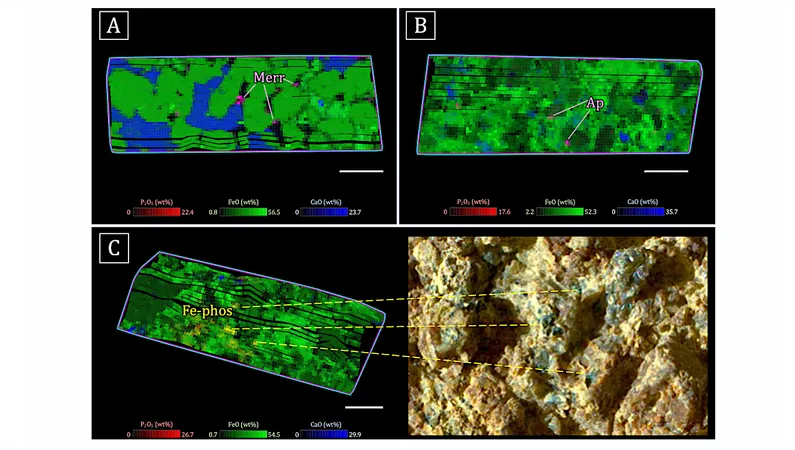
Unlocking the Secrets of Phosphates on Mars: Clues to Past Life and Geological History!
2025-01-12
Author: Li
Recent Research on Martian Phosphates
Recent research has brought to light the fascinating role of phosphates on Mars, providing critical insights into the planet's ancient volcanic and watery past, as well as potential indicators of prebiotic chemistry and habitability. This study dives deep into the types of phosphates found in Martian meteorites and those detected by various spacecraft missions, revealing a treasure trove of information that could reshape our understanding of Mars' history.
Types of Phosphates Found
As of 2023, scientists have analyzed 378 meteorites from Mars, uncovering that two of the most prevalent phosphate minerals encountered are merrillite and apatites. Notably, the composition of these phosphate minerals is rich in fluorine and chlorine, with shergottites (a type of Martian meteorite) exhibiting heightened levels of hydroxyl (OH). This discovery raises the prospect of examining Martian geology and atmospheric conditions during its formative years.
Concentration Analysis Across Missions
Concentration analysis conducted across different landing missions shows intriguing variations. Higher phosphate concentrations were found in the Mount Sharp Group of Gale Crater and at the Wishstone location in Gusev Crater, while lower concentrations were seen on the Jezero Crater floor and the Jezero fan. This spatial distribution could signify different environmental conditions in these areas, thus offering hints about Mars's past climatic diversity.
Investigation of Secondary Phosphates
Additionally, the study investigated possible secondary phosphates on the Martian surface, including iron phosphates in Jezero and Gusev craters. The findings on the formation temperatures and solubility of secondary phases present intriguing questions about the historical fluid activity on Mars, which might have played a pivotal role in shaping its geological landscape.
Future Exploration Needs
Despite the extensive data gathered so far, the fine scale and relatively low concentrations of phosphates necessitate further exploration. The upcoming Mars Sample Return mission is seen as crucial for acquiring samples that could illuminate the intricate history of phosphates and their significance concerning the planet’s igneous, aqueous, and astrobiological narratives.
Conclusion and Future Prospects
As we stand on the cusp of potentially groundbreaking discoveries, these phosphates may not only reveal Mars’s geological secrets but also provide invaluable clues about the possibility of life beyond Earth. Are we on the brink of discovering whether Mars once hosted life forms? The quest continues!



 Brasil (PT)
Brasil (PT)
 Canada (EN)
Canada (EN)
 Chile (ES)
Chile (ES)
 Česko (CS)
Česko (CS)
 대한민국 (KO)
대한민국 (KO)
 España (ES)
España (ES)
 France (FR)
France (FR)
 Hong Kong (EN)
Hong Kong (EN)
 Italia (IT)
Italia (IT)
 日本 (JA)
日本 (JA)
 Magyarország (HU)
Magyarország (HU)
 Norge (NO)
Norge (NO)
 Polska (PL)
Polska (PL)
 Schweiz (DE)
Schweiz (DE)
 Singapore (EN)
Singapore (EN)
 Sverige (SV)
Sverige (SV)
 Suomi (FI)
Suomi (FI)
 Türkiye (TR)
Türkiye (TR)
 الإمارات العربية المتحدة (AR)
الإمارات العربية المتحدة (AR)